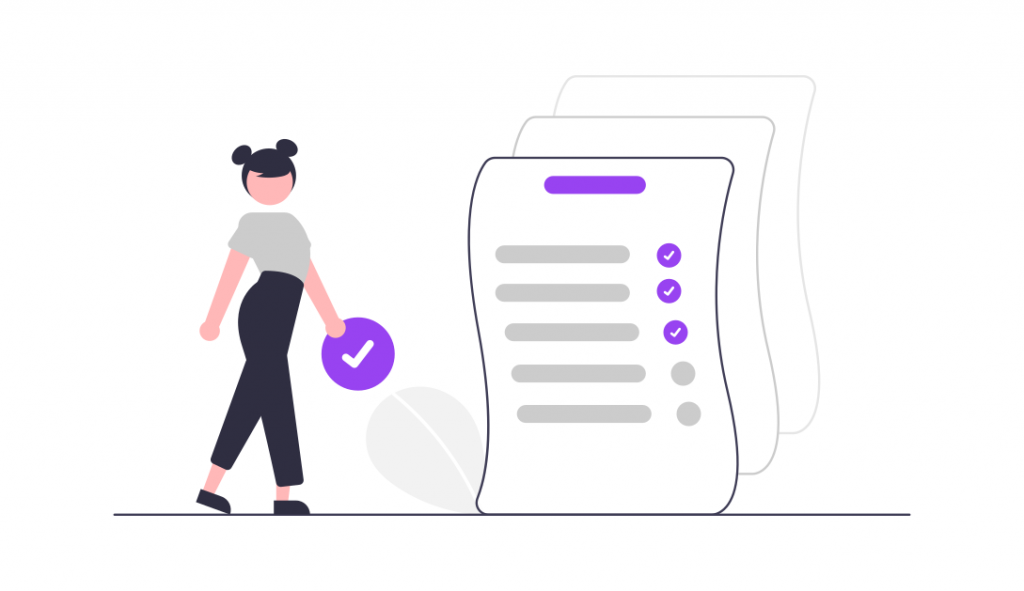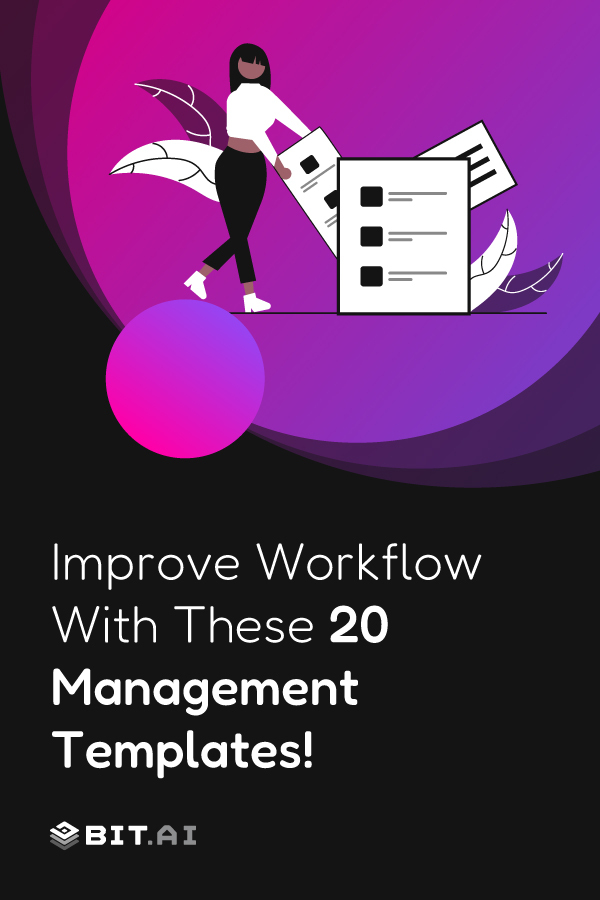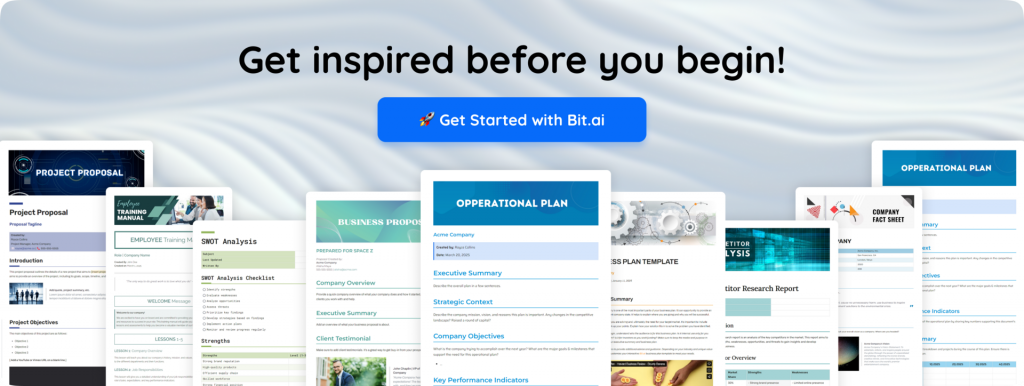Management documents are essential tools that help keep your business organized and efficient. These documents play a crucial role in various types of management, from financial oversight to risk assessment and project coordination. They provide structure, ensure consistency, and facilitate clear communication within your team.
Now, think about the hassle of compiling a marketing plan or developing a detailed budget sheet. Wouldn’t it be great if you had ready-made templates to simplify this process?
Imagine having all the necessary management document templates in one place, saving you time and reducing stress. Well, you don’t have to imagine anymore! We’ve compiled a list of essential management document templates that cover everything you need, from financial forecasting and risk management to meeting agendas and reports.
Our complete blog post will guide you through each template, explaining their importance and how to use them effectively. So, dive in and explore how these templates can align your management processes, enhance productivity, and help you focus on what matters most – growing your business.
In this section, we’re discussing 20 essential templates across various categories, from finance and meeting management to marketing and project planning. Having these templates is crucial for efficiency and organization as they save you time and ensure consistency in your processes. So, let’s read on and explore more!
Project Management Templates
1. Project Charter Template
A project charter is your project’s guiding document. It’s essentially your project’s birth certificate. You create it at the start to outline the project’s scope, objectives, and participants. It’s an essential communication tool that aligns all stakeholders, providing a clear understanding of the project’s purpose and direction. This document is a high-level overview, providing a clear statement of what the project will achieve and how success will be measured. To explore what’s included in a project charter template, let’s delve into its key elements:
- Project Title: A clear and concise name for the project.
- Project Purpose and Justification: Explains why the project is being undertaken and what problem it aims to solve.
- Objectives: Specific, measurable goals the project aims to achieve.
- Scope: Defines what will and won’t be included in the project.
- Deliverables: Tangible outcomes or products that will be delivered.
- Timeline: Key milestones and deadlines.
- Budget: An estimate of the costs involved.
- Key Stakeholders: Individuals or groups with an interest in the project.
- Roles and Responsibilities: Specific duties of team members and stakeholders.
- Approvals: Signatures from key stakeholders to officially start the project.
Transitioning from the high-level overview of a project charter, we next consider a more detailed planning document to ensure project success.
Bonus Resources:

2. Project Plan Template
A project plan is your map to success. It lays out how your project will be executed, monitored, and controlled. The project plan is created after the project charter and is much more detailed. It provides the team with a structured approach to follow, ensuring everyone knows their roles, timelines, and deliverables. To better understand the components of a project plan template, let’s break down the essential elements included:
- Project Scope Statement: Detailed description of what the project will deliver.
- Work Breakdown Structure (WBS): Divides the project into manageable sections.
- Schedule: Timeline of activities and milestones.
- Resource Plan: Details of resources (people, equipment, materials) required.
- Budget Plan: Comprehensive breakdown of costs.
- Risk Management Plan: Identification and mitigation strategies for potential risks.
- Quality Plan: Standards and criteria for project deliverables.
- Communication Plan: How information will be shared among stakeholders.
- Stakeholder Management Plan: Engagement strategies for stakeholders.
- Change Management Plan: Process for handling changes to the project.
Moving from planning to visual representation, we next discuss a tool that helps track project progress over time.
Bonus Resource:
3. Gantt Chart Template
A Gantt chart is your visual timeline for the project. It’s a type of bar chart that represents a project schedule, showing the start and finish dates of various elements. With a Gantt chart, you can see at a glance how tasks overlap, their durations, and their sequential order. It’s incredibly helpful for keeping everyone on the same page and ensuring the project stays on track. Understanding the parts of a Gantt chart template can enhance its usefulness:
- Project Tasks: List of activities and tasks.
- Task Duration: Start and end dates for each task.
- Dependencies: Relationships between tasks (which tasks need to be completed before others can start).
- Milestones: Key dates and events within the project.
- Progress Tracking: Indicators of how much of each task is completed.
- Resource Allocation: Who is responsible for each task.
- Timeline: Horizontal time axis showing the schedule.
- Critical Path: Sequence of tasks that determine the project’s duration.
From visual tracking, we shift focus to monitoring and reporting, ensuring ongoing transparency and accountability.
4. Project Status Report Template
A project status report keeps everyone informed about how the project is progressing. This document is regularly updated and shared with your stakeholders, providing insights into what has been accomplished, upcoming tasks, and any issues or risks. It helps ensure transparency and keeps everyone aligned on the project’s progress and any changes. Let’s delve into the main elements included in a project status report template:
- Project Overview: Brief summary of the project’s status.
- Milestone Progress: Update on key milestones.
- Task Completion: Status of individual tasks (completed, in progress, or pending).
- Schedule Status: Comparison of planned vs. actual timelines.
- Budget Status: Summary of expenditures vs. budget.
- Risk Management: Current risks and mitigation strategies.
- Issues: Any problems that have arisen and how they are being addressed.
- Next Steps: Upcoming tasks and deadlines.
- Team Updates: Information on team performance and changes.
- Stakeholder Feedback: Insights or feedback from stakeholders.
Template: Project Status Report Template by Bit.ai

Financial Management Templates
1. Budget Template
Managing finances effectively begins with a clear budget. A budget template helps you plan and track your income and expenses over a specific period, usually monthly or annually. It allows you to allocate funds wisely, ensuring you have enough resources for essential activities while avoiding overspending. Creating and following a budget gives you financial control and helps you make informed decisions about where to allocate resources. Let’s explore the key components typically included in a budget template:
- Income: Sources of revenue or income streams.
- Expenses: Categories for different types of expenditures (e.g., salaries, utilities, marketing).
- Budgeted Amount: Planned or allocated amount for each expense category.
- Actual Amount: Actual expenditure or income received for each category.
- Variances: Differences between budgeted and actual amounts.
- Notes or Comments: Explanations for significant variances or adjustments.
- Financial Goals: Specific targets or objectives for saving or spending.
2. Cash Flow Statement Template
Understanding cash flow is crucial for financial stability. A cash flow statement template helps you monitor the movement of cash in and out of your business over a period. It shows how changes in balance sheet accounts and income affect cash and cash equivalents. This statement helps you manage liquidity and ensures you have enough cash to cover expenses and invest in growth opportunities. To delve deeper into a cash flow statement template, here are the typical elements it includes:
- Operating Activities: Cash inflows and outflows from core business operations.
- Investing Activities: Cash transactions related to investments in assets or securities.
- Financing Activities: Cash flows from financing sources like loans, equity, or dividends.
- Net Cash Flow: Overall change in cash and cash equivalents.
- Beginning and Ending Cash Balance: Cash position at the beginning and end of the period.
- Non-Cash Transactions: Items that affect net income but don’t involve actual cash flow.
From tracking cash flow, understanding your profitability is essential, which leads us to explore a profit and loss statement (P&L) template.
3. Profit and Loss Statement (P&L) Template
A Profit and Loss (P&L) statement is a financial report that summarizes your business’s revenues, expenses, and profits (or losses) over a specific period. It provides insights into your company’s ability to generate profit by increasing revenue and managing costs effectively. Analyzing a P&L statement helps you assess financial performance, identify trends, and make informed decisions to improve profitability. Exploring the components of a P&L statement template sheds light on what it typically includes:
- Revenue: Total income generated from sales or services.
- Cost of Goods Sold (COGS): Direct costs related to producing goods or services.
- Gross Profit: Revenue minus COGS, showing profitability before operating expenses.
- Operating Expenses: Costs incurred in running the business (e.g., salaries, rent, utilities).
- Operating Income: Gross profit minus operating expenses, indicating profitability from core operations.
- Non-Operating Items: Income or expenses not directly related to core operations.
- Net Profit (or Loss): Total income after deducting all expenses and taxes.
- Earnings Before Interest, Taxes, Depreciation, and Amortization (EBITDA): Indicator of operating performance.

4. Balance Sheet Template
Understanding your organization’s financial health is crucial for making informed decisions. A balance sheet template provides a snapshot of your company’s assets, liabilities, and equity at a specific point in time. It helps you assess your company’s financial position by showing what you own (assets), what you owe (liabilities), and the difference between them (equity). This document is essential for investors, creditors, and management to gauge the overall financial stability and performance of your business.
To explore what’s typically included in a balance sheet template, let’s break down its key components:
- Assets: List of resources owned by the company, categorized as current (short-term) and non-current (long-term).
- Liabilities: Debts and obligations owed by the company, also categorized as current and non-current.
- Equity: The difference between assets and liabilities, representing the net worth of the company.
- Current Ratios: Calculation of current assets divided by current liabilities to assess liquidity.
- Fixed Assets: Tangible assets like property, equipment, and intangible assets like patents.
- Debt Analysis: Breakdown of debts owed, including interest rates and repayment terms.
- Equity Analysis: Details of shareholders’ equity, including retained earnings and capital contributions.
- Financial Ratios: Key ratios such as debt-to-equity ratio or current ratio for financial analysis.
Transitioning from understanding your current financial position, let’s explore how financial forecasting can help you plan for the future.
5. Financial Forecasting Template
Predicting future financial outcomes is essential for effective planning and decision-making. A financial forecasting template helps you estimate your organization’s future financial performance based on historical data, market trends, and business plans. It allows you to forecast revenues, expenses, cash flow, and profitability over a specific period, such as the next quarter or year. This document is valuable for setting realistic goals, allocating resources effectively, and identifying potential financial challenges or opportunities. To delve into the elements typically included in a financial forecasting template, let’s outline its key components:
- Sales Forecast: Predictions of future sales revenue based on market demand and historical sales data.
- Expense Forecast: Estimated costs and expenditures required to operate the business.
- Cash Flow Forecast: Projection of cash inflows and outflows to ensure sufficient liquidity.
- Profit Forecast: Expected profitability, factoring in revenue and expenses.
- Scenario Analysis: Evaluation of different scenarios (optimistic, pessimistic) to assess potential outcomes.
- Assumptions: Factors and variables influencing the forecast, such as market conditions or economic trends.
- Sensitivity Analysis: Testing the impact of changes in assumptions on the forecasted results.
- Financial Statements: Projected income statement, balance sheet, and cash flow statement based on the forecast.
Marketing Management Templates
1. Marketing Plan Template
Your marketing plan is the blueprint for achieving your marketing goals. It outlines your strategy, target audience, budget, and the specific actions you’ll take to reach your goals. This detailed document guides your marketing efforts and helps you stay focused on your objectives. Creating a marketing plan ensures you have a clear path and a set of metrics to measure your success. To get a deeper understanding of what makes a marketing plan template effective, let’s look at its core components:
- Executive Summary: A brief overview of the main goals and strategies.
- Market Research: Analysis of the market conditions, including trends and customer insights.
- Target Audience: Detailed profiles of your ideal customers.
- Marketing Objectives: Specific, measurable goals you aim to achieve.
- Strategies and Tactics: The approaches and actions you’ll take to meet your objectives.
- Budget: Allocation of funds for different marketing activities.
- Timeline: Schedule of when each action will take place.
- Metrics and KPIs: How you’ll measure success and track progress.
- SWOT Analysis: Identifying strengths, weaknesses, opportunities, and threats.
With your marketing plan in place, you can further analyze your position using a SWOT analysis, providing deeper insights into your strategy.

2. SWOT Analysis Template
SWOT analysis helps you understand your business environment. By identifying strengths, weaknesses, opportunities, and threats, you can make informed decisions. This tool is crucial for strategic planning, giving you a clear picture of where you stand and where you can improve.
Diving into the specifics, let’s examine the elements included in a SWOT analysis template:
- Strengths: Internal attributes and resources that support a successful outcome.
- Weaknesses: Internal factors that might hinder your progress.
- Opportunities: External factors you can leverage for growth.
- Threats: External challenges that could cause problems.
- Analysis Summary: A comprehensive overview of the findings.
- Action Plan: Steps to capitalize on strengths and opportunities, and to mitigate weaknesses and threats.
- Competitive Analysis: Evaluation of competitors and their impact on your SWOT.
- Market Trends: Insights into current trends affecting your business.
- Resource Allocation: How to best use your resources based on the analysis.
After analyzing your SWOT, organizing your content becomes the next step in your marketing strategy, which is where a content calendar comes into play.
Resource: SWOT Analysis Template
3. Content Calendar Template
Your content calendar is a visual planner for your marketing content. It helps you schedule and organize what content to publish, when, and where. This ensures consistency, maximizes engagement, and keeps your marketing efforts on track. Having a content calendar prevents last-minute rushes and helps you plan content around key dates and events.
Let’s explore the essential parts of a content calendar template:
- Monthly Calendar: Visual layout of your content schedule.
- Content Topics: List of themes and topics for your content.
- Publication Dates: Specific dates when each piece of content will be published.
- Content Type: Format of the content (blog posts, videos, social media posts, etc.).
- Responsible Person: Who is in charge of creating and publishing the content.
- Distribution Channels: Platforms where the content will be shared.
- Keywords and SEO: Focus keywords for each piece of content.
- Status Tracker: Progress of each content piece (planned, in progress, published).
- Engagement Metrics: How each piece of content performed.
With your content well-organized, the next step is to plan your marketing campaigns effectively using a campaign planning template.
Resource: Content Calendar Template

4. Campaign Planning Template
Your campaign planning template is the roadmap for executing your marketing campaigns. It outlines the strategy, timeline, budget, and key performance indicators (KPIs) for each campaign. This template ensures that all elements of your campaign are aligned and executed seamlessly, helping you achieve your marketing objectives. To understand the full scope of a campaign planning template, let’s break down its key components:
- Campaign Name: Clear and concise title of the campaign.
- Objectives: Specific goals you aim to achieve with the campaign.
- Target Audience: Detailed description of the audience you’re targeting.
- Message and Theme: Core message and overall theme of the campaign.
- Channels: Platforms and media where the campaign will be executed.
- Timeline: Schedule of all campaign activities and milestones.
- Budget: Allocation of funds for various campaign activities.
- Creative Brief: Guidelines for the creation of campaign content.
- KPIs and Metrics: How success will be measured and tracked.
- Roles and Responsibilities: Who is responsible for each aspect of the campaign.
Bonus: Uncover Market Trends & Insights Easily – Get the Market Research Template By Bit.ai
Risk Management Templates
1. Risk Register Template
Managing risks is essential for any organization’s success. A risk register template helps you identify, assess, and prioritize potential risks that could impact your projects or business operations. It serves as a central repository for recording all identified risks, their potential impact, and mitigation strategies. By maintaining a risk register, you can proactively address risks before they escalate into issues, minimizing potential disruptions and maximizing opportunities. To understand what’s typically included in a risk register template, let’s explore its key components:
- Risk Identification: Clearly defining each potential risk.
- Risk Description: Detailed explanation of the nature and characteristics of the risk.
- Risk Impact: Assessment of the potential consequences if the risk occurs.
- Likelihood: Probability of the risk occurring.
- Risk Owner: Person responsible for monitoring and managing the risk.
- Mitigation Actions: Strategies and actions to reduce the likelihood or impact of the risk.
- Contingency Plans: Backup plans in case the risk materializes.
- Risk Status: Current status of the risk (e.g., open, mitigated, closed).
- Monitoring and Review: Regular review process to update risk status and mitigation efforts.
Transitioning from risk identification to response, let’s now explore how to manage incidents effectively using a template.
2. Incident Report Template
An incident report is crucial for documenting and managing unexpected events or incidents within your organization. It provides a structured way to record details of incidents, including what happened, when it occurred, and who was involved. This document helps you investigate incidents thoroughly, understand root causes, and implement preventive measures to minimize recurrence. Exploring the elements typically included in an incident report template reveals its importance:
- Incident Details: Date, time, and location of the incident.
- Description: Detailed account of what happened.
- Impact: Consequences and effects of the incident.
- Persons Involved: Names and roles of individuals directly affected or involved.
- Witnesses: Names and contact information of witnesses, if any.
- Investigation Findings: Analysis of the incident, including root causes.
- Corrective Actions: Steps taken or recommended to prevent future incidents.
- Follow-up: Monitoring and review process to ensure actions are implemented.
- Recommendations: Additional suggestions or improvements to prevent similar incidents.
From incident response, it’s crucial to plan for continuity in the face of disruptions, which leads us to explore a business continuity plan template.

3. Business Continuity Plan Template
A business continuity plan (BCP) is essential for ensuring your organization can continue operating during and after a disruption. This template outlines procedures and strategies to maintain essential business functions, services, and operations during emergencies such as natural disasters, IT system failures, or other crises. To understand what’s typically included in a business continuity plan template, let’s explore its elements:
- Purpose and Scope: Overview of why the plan is needed and what it covers.
- Key Personnel: Roles and responsibilities of individuals involved in executing the plan.
- Risk Assessment: Identification of potential threats and vulnerabilities.
- Business Impact Analysis: Assessment of the impact of disruptions on business operations.
- Recovery Strategies: Plans and procedures to recover critical functions and operations.
- Communication Plan: Strategies for internal and external communication during a crisis.
- Testing and Maintenance: Schedule for testing the plan and keeping it updated.
- Incident Response: Immediate actions to be taken when a disruption occurs.
- Resource Requirements: Resources needed to execute the plan effectively.
Meeting Management Templates
1. Meeting Agenda Template
Your meeting agenda is the blueprint for your meeting. It outlines the topics to be discussed, the order of discussion, and the time allotted for each topic. Having a clear agenda ensures that the meeting stays on track and that all important points are covered. It helps participants prepare in advance and contributes to a more productive and focused meeting. Exploring the components of a meeting agenda template reveals its structure:
- Meeting Title: The name or purpose of the meeting.
- Date and Time: When the meeting will take place.
- Location: Where the meeting will be held, whether in-person or virtually.
- Attendees: List of people who will be present.
- Agenda Items: Specific topics to be discussed.
- Presenter: Person responsible for each agenda item.
- Time Allotment: Time allocated for each agenda item.
- Objectives: Goals or outcomes expected from the meeting.
- Preparation: Any materials or information attendees need to review beforehand.
Transitioning from planning to recording, let’s now consider how to document the discussions and decisions made during the meeting.
Resource: Meeting Agenda Template

2. Meeting Minutes Template
Meeting minutes are the official record of what was discussed and decided during a meeting. They provide a summary of the key points, decisions made, and actions assigned. Keeping accurate minutes ensures that everyone has a clear understanding of the outcomes and can follow up on action items. Diving into the elements of a meeting minutes template shows what to capture:
- Meeting Title: Name or purpose of the meeting.
- Date and Time: When the meeting took place.
- Location: Where the meeting was held.
- Attendees: List of participants present.
- Agenda Items: Topics that were discussed.
- Discussion Summary: Brief overview of the discussions for each agenda item.
- Decisions Made: Record of any decisions or resolutions passed.
- Action Items: Specific tasks assigned, including responsible persons and deadlines.
- Next Meeting: Date and time of the next scheduled meeting.
- Notes: Any additional remarks or comments.
From documenting decisions, we now move to ensuring those decisions are acted upon with a tool for tracking progress.
Resource: Meeting Minutes Template
3. Action Items Tracker Template
Your action items tracker keeps everyone accountable. It lists tasks assigned during meetings, ensuring that they are completed on time. This document helps track progress, making sure nothing falls through the cracks. It’s a vital tool for maintaining momentum and ensuring follow-through on decisions made. Exploring an action items tracker template highlights its critical components:
- Task Description: Detailed description of each action item.
- Assigned To: Person responsible for completing the task.
- Due Date: Deadline for when the task should be completed.
- Status: Current status of the task (e.g., not started, in progress, completed).
- Priority: Importance level of the task (e.g., high, medium, low).
- Comments: Additional notes or context for the task.
- Completion Date: Actual date when the task was finished.
Here’s a action item tracker template to get started:
Meeting Title: [Insert Meeting Title]
Date: [Insert Date]
| No. | Task Description | Assigned To | Due Date | Status | Priority | Comments | Completion Date |
| 1. | [Task 1 description] | [Assignee Name] | [Due Date] | [Not started] | [High] | [Additional notes] | [Completion Date] |
| 2. | [Task 2 description] | [Assignee Name] | [Due Date] | [In progress] | [Medium] | [Additional notes] | [Completion Date] |
| 3. | [Task 3 description] | [Assignee Name] | [Due Date] | [Completed] | [Low] | [Additional notes] | [Completion Date] |
| … | … | … | … | … | … | … | … |
Total Tasks: [Total number of tasks]
Alongside tracking action items, keeping track of attendance is essential to ensure accountability and participation in meetings.
4. Meeting Attendance Sheet Template
Your meeting attendance sheet is a straightforward record of who attended your meeting. This document ensures you have a clear record of participation, which can be important for follow-up and accountability. It helps you know who was present, who missed the meeting, and can be useful for tracking attendance over time.

Looking at the essential components of a meeting attendance sheet template gives clarity on its function:
- Meeting Title: Name or purpose of the meeting.
- Date and Time: When the meeting took place.
- Location: Where the meeting was held.
- Attendee Names: List of participants’ names.
- Signatures: Space for attendees to sign in, confirming their presence.
- Contact Information: Optional field for attendees’ email or phone number.
- Notes: Any additional remarks or observations.
- Absentees: List of those who were expected but did not attend.
- Total Count: Number of attendees present.
You can also use this meeting attendance sheet to keep a record of who participated in your meeting:
Meeting Title: [Insert Meeting Title]
Date and Time: [Insert Date and Time]
Location: [Insert Location]
| No. | Attendee Name | Signature | Contact Info (Optional) |
| 1. | [Attendee 1 Name] | [Signature] | [Email / Phone] |
| 2. | [Attendee 2 Name] | [Signature] | [Email / Phone] |
| 3. | [Attendee 3 Name] | [Signature] | [Email / Phone] |
| … | … | … | … |
Absentees: [List of absentees]
Total Attendance: [Total number of attendees]
By keeping an attendance sheet, you ensure a record of participation, which complements the tracking of tasks and decisions discussed in the meeting.
Conclusion
Throughout this discussion, you’ve learned about 20 essential management document templates that can align your processes and boost productivity.
Now that you’re equipped with knowledge on these templates, it’s time to put them into action. Use these templates to organize your finances, plan meetings, create marketing strategies, and manage projects more efficiently. Ready to manage like a pro? Dive in, and make your business run smoother than ever. Remember: “Why reinvent the wheel when you can download it?”
FAQs
Which of these 20 templates should I start with as a small business owner?
Start with the basics that directly affect day-to-day operations: the Project Charter, Budget, Cash Flow Statement, Marketing Plan, and Meeting Agenda. These give you clarity on scope, finances, strategy, and team coordination. Once these are in place, you can add templates like the Risk Register and Action Items Tracker to strengthen your workflow.
Can I customize these templates to fit my team’s needs?
Yes, every template can be adjusted. You can rename sections, add fields, remove items you don’t need, or change the formatting. Templates are meant to offer structure, but they should always be shaped around your actual process.
How often should I update templates like the Project Status Report or Financial Forecast?
Project Status Reports are usually updated weekly or monthly depending on how fast the project is progressing. Financial Forecasts are often updated monthly or quarterly, and also whenever key assumptions change. Regular updates help everyone stay informed and prevent surprises.
Who should own and maintain these management documents?
Ownership depends on the type of document. Project managers often maintain project-related documents, finance teams handle budgets and P&L statements, and marketing teams manage the marketing plan and content calendar. Even with clear ownership, teams should collaborate and share input.
Where should we store and share these templates so they stay organized and accessible?
Use a central platform for all your documents. Store, share, update, and track versions there. This way, you avoid duplicate files, maintain consistency, and allow teams to work in sync without any mix-ups.
Further reads:
- 20 Most Popular Construction Document Templates (Editable)
- 10 Essential Team Metrics to Measure and Improve Performance!
- Sales Manager Job Description: How to Write it? (Steps & Example Included)
- Financial Plan: What is it & How to Create an Impressive One?



